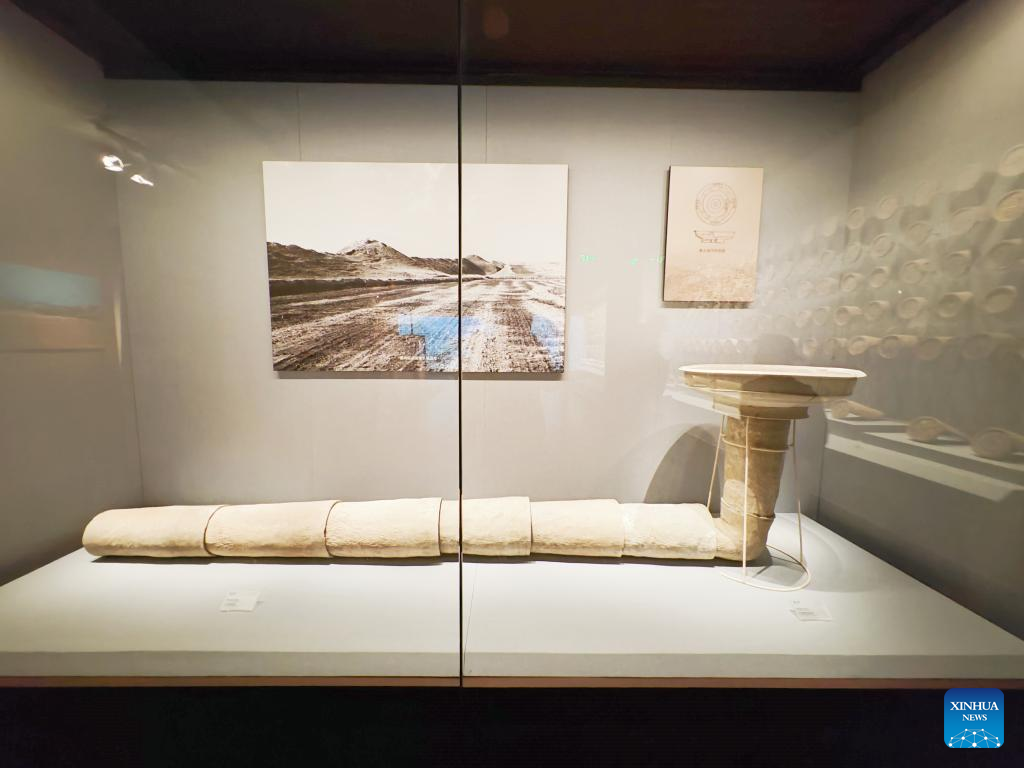Enduring memories of Red Army amidst Great Wall ruins in NW China
From:XinhuaAuthor: 2023-11-10 10:24

A clay component of drainage system used on an ancient Great Wall dating back to the Warring States period (475-221 BC) is on display at a museum dedicated to the Great Wall in Guyuan City, northwest China's Ningxia Hui Autonomous Region, Sept. 6, 2023. (Xinhua)
Hu Junlong, a 70-year-old retired teacher, always shows three "heirlooms" to guests visiting his home in Caotan Village in Pengyang County, located in northwest China's Ningxia Hui Autonomous Region.
The treasured objects are replicas of two grenades and a landmine. "The original pieces of the ammunition were unearthed in 2015 during renovations of our family courtyard. I later learned that they were left behind by Red Army soldiers who stayed in this ancestral house in 1935 during the Long March," said Hu, referring to the epic and arduous journey undertaken by the Chinese Red Army from 1934 to 1936.
According to Hu, three soldiers had stayed in Hu's house and received food, shelter, and other assistance from his father and other family members. One soldier surnamed Guo had sustained injuries on his left leg. He stayed for a couple of weeks and was well cared for, forging a deep bond between them.
Remarkably, Guo and Hu's father reconnected three years later, and their friendship endured throughout their lives.
Hu turned over the ammunition to the local police station shortly after their discovery. However, to keep the precious memory alive, he managed to have their replicas crafted. These replicas are meticulously designed to appear weathered, covered with a thick layer of "rust," closely resembling the authentic pieces.
Hu is one of many Pengyang locals who hold a deep connection to Red Army soldiers who passed through southern Ningxia in October 1935 and crossed the Liupan Mountain, also known as Spiral Mountain, after defeating enemies that emerged to intercept them. This is considered a key turning point in the Long March that led to the final victory.
A similar emotional bond is also closely linked to a local site of an ancient Great Wall dating back to the Warring States period (475-221 BC), which is located less than four km away from the former Red Army headquarters camp.
Si Pengfei, head of Pengyang's culture and history management office, said the Red Army relied on the Great Wall ruins both for navigation and as a protective shield during their journey in the region.
When Mao Zedong led the Red Army through the region in October 1935, he composed a renowned song poem dedicated to the Spiral Mountain to celebrate the unwavering determination and bravery of the soldiers during the Long March.
"The sky is high, the clouds are light/The wild geese flying south are out of sight/We are not heroes unless we reach the Great Wall/Counting up, we've done twenty thousand li in all," the poem goes.
Shao Yongjie, a locally based writer and historian, believes that the poem underscores the symbolic importance of the ancient Great Wall in Pengyang, inspiring Red Army soldiers to keep up morale and contribute to establishing a national united front to resist the Japanese aggressors.
Over the past several years, the local government has invested over 35 million yuan (about 4.88 million U.S. dollars) for the restoration and preservation of the Great Wall ruins, while developing history and patriotism-themed tours and promoting rural tourism, attracting over 100,000 tourists annually.
An 11-member team patrols the ruins daily to help with its preservation "so that future generations can continue to learn about this significant chapter of history," Si said.
In the city of Guyuan, which administers Pengyang County, a museum dedicated to the Great Wall was opened in May, featuring over 1,100 relics in a 2,000 square-meter space, to showcase its former glory.
A memorial hall has also been built on the former site of the Red Army headquarters camp. "This place is very well received by visitors because it resurrects a pivotal period in Chinese history when the Red Army was about to end the Long March in victory," explained Wang Ying, a tour guide at the memorial hall.
Edit:董丽娜
The copyright of the article and the picture belongs to the original author. If there is any infringement, please contact to delete it